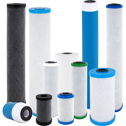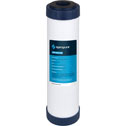How Do Activated Charcoal Water Filters Work? A Complete Guide
 Andrew
May 08, 2025
#activatedcarbon
#activatedcharcoal
#carbonfilter
#catalyticcarbon
#chlorine
Andrew
May 08, 2025
#activatedcarbon
#activatedcharcoal
#carbonfilter
#catalyticcarbon
#chlorine

If you've been researching water filtration options, you've likely encountered both "charcoal filters" and "carbon filters" in your search. Here's the simple truth: these terms essentially refer to the same technology. Both use activated carbon as their filtration medium, with "charcoal" being the more consumer-friendly, traditional term and "carbon" being the more technically precise industry term.
The key difference lies not in the terminology but in the activation process and source material. Wood is the source for most charcoal while many high-quality filters today often use activated carbon derived from coconut shells, which provides superior adsorption properties compared to other carbon sources. When you see "activated charcoal filter" or "activated carbon filter" on a product label, you're looking at fundamentally the same technology.
How Activated Carbon Water Filters Work
Activated carbon represents one of history's oldest water treatment technologies that remains cutting-edge even today. The transformation from regular charcoal to activated carbon involves a two-stage process:
First, carbon-rich organic materials such as coconut shells, wood, coal, or bamboo undergo carbonization, where they're heated to 1100–1700°F in an oxygen-deprived environment. This process removes non-carbon elements and creates a basic char structure.
The magic happens in the second step, where the carbonized material is placed in an inert atmosphere and then "activated" by steam and oxygen at high temperatures between 1100°F and 2200°F. Activation opens a vast network of microscopic pores and dramatically increases the surface area. Amazing as it sounds, one gram of activated carbon can have a surface area exceeding 32,000 square feet. Picture a sheet of paper crumpled up as small as possible to get a sense for this property.
The resulting honeycomb-like structure features pores of various sizes that work together as a complete filtration system. The enormous surface area, natural affinity for organic compounds, and multi-layered structure all combine to make activated carbon so effective at removing a wide range of impurities from your water. And this effect has a name.

In activated carbon filtration, contaminant molecules physically bond to the carbon's internal surface area while water molecules pass through. This process is called adsorption, not to be confused with absorption. While absorption involves a substance being soaked up throughout a material like a sponge, adsorption occurs when molecules adhere to a surface.
Physical adsorption occurs when contaminants are attracted to the carbon's surface due to weak attraction between molecules known as van der Waals forces. Chemical adsorption happens when contaminants react with the carbon's surface or with functional groups created during the activation process, forming stronger bonds. Activated carbon operates primarily by physical adsorption, while the special properties of catalytic carbon also promote chemical bonds.
What makes activated carbon particularly remarkable is its selectivity. It has a strong affinity for organic compounds, chlorine, and many chemicals that affect taste and odor, while allowing beneficial minerals to pass through. This selectivity makes it ideal for drinking water applications where removing contaminants without demineralizing the water is desirable.
Granular Activated Carbon (GAC) consists of loose carbon granules that allows for more contact between the water and carbon. These filters offer excellent water flow rates and adsorption properties and are commonly used in whole-house filtration systems to reduce chlorine taste and odor. The loose configuration provides good contaminant reduction but may allow some channeling (water finding paths of least resistance through the media). For example, a 20-micron filter will reduce chlorine, many chemicals, bad tastes and odors, and remove larger debris and particles. Depending on the input water quality, a smaller micron rating may be helpful.
Powdered Activated Carbon (PAC) consists of very fine carbon particles and have a variety of cartridge designs, making them a great choice for a wide range of applications including residential, food service, commercial, and industrial water filtration. PAC filters come in a variety of ratings (typically 0.5 to 10 micron) and their porous composition offers a high dirt holding capacity with reduced clogging. This allows the filter to maximize carbon use while maintaining a low pressure drop.
Carbon Block Filters compress activated carbon particles with a binding agent into a solid, dense block. These filters typically offer enhanced filtration compared to GAC because of their density. Their compressed nature forces water through more carbon, capturing more impurities, though often at the expense of flow rate.
Catalytic Carbon represents an enhanced version of activated carbon specially modified by catalyzed iron-hydroxide to improve its capability for removing chloramines, hydrogen sulfide, and certain other impurities that regular activated carbon struggles to address. This specialized media undergoes additional processing to alter its surface structure, making it particularly valuable at the 1 micron rating for point-of-use treatment of well water where sulfur odors may be present and other whole house filtration systems tackling bad taste, odors, PFAS, trihalomethanes (THMs), and heavy metals.
Practical Applications in Home Water Filtration
Activated charcoal water filters can be implemented throughout your home or operation in various ways:
Point-of-Entry (Whole House) Systems treat all water entering your home before it reaches any fixtures. These systems typically use larger carbon filter tanks or cartridges and protect your entire plumbing system and all water-using appliances. Whole house carbon water filter replacements are particularly valuable for removing chlorine, which can damage rubber seals and plumbing components over time, while also addressing taste and odor issues throughout the home.

- Under-sink single housing or multi-stage systems using PAC, GAC, and/or carbon block filter types
- Inline and refrigerator filters that connect to your ice maker and water dispenser
- Faucet-mounted filters for direct tap filtration
- Pitcher filters for refrigerator use
When selecting a charcoal filter for well water specifically, you'll often need a multi-stage system that addresses the unique challenges of groundwater. Well water frequently contains sediment, iron, manganese, and sometimes hydrogen sulfide, all requiring specialized treatment in addition to activated carbon filtration.
Understanding both the capabilities and limitations of activated charcoal filtration helps set realistic expectations and ensures you're protected from relevant contaminants in your water supply.
Effectively Removes:
- Chlorine and chlorination byproducts (THMs)
- Many volatile organic compounds (VOCs)
- Pesticides and herbicides
- Many industrial chemicals
- Most compounds affecting taste and odor
- Some heavy metals through specialized carbon formulations
- Radon gas (to some extent)
- Some sediment and particles (primarily in carbon block format)
- Dissolved inorganic compounds like fluoride and nitrates
- Most minerals that contribute to water hardness
- Sodium and other salts
- Most radioactive contaminants
- Microorganisms like bacteria and viruses (unless using specialized bacteriostatic carbon)
- Very small molecules that pass through carbon's pore structure
A Note About Carbon Water Filter vs. Reverse Osmosis
When considering comprehensive water filtration, consumers often compare activated carbon filters with reverse osmosis (RO) systems. While carbon excels at removing certain contaminants, RO systems use a semi-permeable membrane that can reduce up to 99% of all dissolved solids, providing more thorough filtration that includes minerals and salts that carbon cannot capture.
The ideal approach often combines these technologies, with carbon filters serving either as pre-treatment for RO systems (protecting the membrane from chlorine damage) or as post-treatment "polish" (improving taste after RO filtration), and often both. This complementary relationship explains why most premium water filtration systems incorporate both technologies rather than relying exclusively on one.
Lifespan and Replacement Considerations
A critical aspect of charcoal water filter performance is understanding its capacity limitations. All activated carbon filters have a finite adsorption capacity. Eventually, their surfaces become saturated with captured contaminants, rendering them ineffective.
Replacement frequency depends on several factors:
- Water quality (higher contaminant levels accelerate saturation)
- Water usage volume
- Filter size and carbon amount
- Carbon quality and activation level
- Flow rate (faster flow reduces contact time and effectiveness)
- Point-of-use carbon filters including refrigerator filters typically require replacement every 3–6 months
- Larger whole-house carbon filters may last 6–12 months
- Premium, high-capacity systems might extend to 12–24 months under ideal conditions
It's worth noting that failing to replace saturated carbon filters doesn't just reduce effectiveness. It can potentially release previously trapped contaminants back into your water. This makes regular maintenance not just a performance issue but a safety consideration as well.
Storage and Handling Requirements
Activated carbon's exceptional adsorption capabilities also make proper storage and handling important. New carbon filters should remain sealed in their original packaging until installation to prevent premature saturation from air contaminants. Once installed, activated carbon filters should remain consistently wet, as allowing them to dry out can reduce effectiveness and potentially create channels through the media that allow water to bypass proper filtration.
When installing replacement filters, follow manufacturer guidelines for any preparation steps such as pre-soaking or flushing, which help remove carbon fines and optimize performance. This is true of refrigerator filters as well. These simple precautions ensure you receive the full benefit from your activated charcoal filtration investment.

Selecting the ideal activated charcoal water filter requires understanding your specific water quality challenges and treatment goals. The first step should always be water testing to identify exactly what contaminants you're facing. Once you know your water profile, consider these factors when selecting a carbon filtration solution:
Filter certification: Some carbon water filters will carry an NSF/ANSI certification or a certification by a third party to NSF standards. A common certification is Standard 42 for aesthetic effects (taste, odor, chlorine), though additional certifications exist.
Carbon quality and source: Premium filters typically use coconut shell carbon, which offers superior adsorption properties compared to coal-based carbon. The activation process and resulting pore structure significantly impact performance.
Flow rate requirements: Consider your household water usage patterns and ensure your chosen filter can handle peak demand without excessive pressure drops that could affect household plumbing.
Filter format: Whether carbon block ("better" filtration but potentially lower flow rates) or granular activated carbon (higher flow rates but potentially less effective filtration) or options in between, pick the type based on your water input quality and filtration priorities.
Micron rating:The micron rating indicates particle size removal capability, with lower numbers (such as 0.5 micron) offering finer filtration than higher ratings (5–20 micron).
Size: Consumer carbon filters typically come in standard sizes such as slim 10" x 2.5" or 20" by 2.5" and "Big Blue" 10" x 4.5" or 20 x 4.5". Big Blue refers to a specific type of filter cartridge housing trademarked by Pentair as part of their Pentak brand lineup. Standard sizes give consumers options for OEM or aftermarket filter replacements. There are also larger format tanks for commercial and industrial applications.
Pre and Post Filtration Needs: Consider whether your water requires additional treatment beyond what carbon can provide, such as sediment pre-filtration or UV disinfection.
For well water applications specifically, remember that activated carbon typically serves as just one component in a comprehensive treatment system that might also include sediment filtration, pH adjustment, and specialized contaminant removal for issues like iron, manganese, or hydrogen sulfide.
Summary
Activated carbon water filters represent one of the most versatile, cost-effective water treatment technologies available today. Their remarkable ability to improve water taste and reduce harmful contaminants through natural adsorption processes makes them a cornerstone of modern water filtration.
Whether you're addressing chlorinated municipal water or complex well water challenges, understanding how activated carbon works allows you to make informed decisions about your water treatment needs. By selecting the right carbon filter format, maintaining it properly, and recognizing when additional treatment technologies might be necessary, you can ensure clean, great-tasting water throughout your home.





